New Dentist Checklist: Keys to Beginning a Successful Laboratory Partnership
Rick Smith CDT; Edited by Edward A. McLaren, DDS
So, you have been successful at completing probably the toughest 8 years of your life. Now what? When beginning your career in private practice, it is essential to avoid any pitfalls that can interfere with anything short of an amazing beginning. Developing a successful laboratory partnership will be one of the most important goals throughout a practice life, but especially when starting out. Patients are esthetically driven to the point that a large part of any practice will be esthetic or cosmetic dentistry. Ideally, the relationship with the laboratory should be viewed in the same way as a relationship with a periodontist or orthodontist with whom you might work. Consistency, predictability, and creativity in any relationship are what keep the stomach lining healthy and the passion intact. This key relationship can keep dentists inspired and engaged with emerging technologies and materials or it can leave dentists in the dark, slowly transforming a dream into drudgery.
Here are some tips to consider when selecting a laboratory partner.
THE FIRST IMPRESSION
We are not talking polyvinyl here. Schedule an on-site visit (Figure 1). See what patients are likely to see when they are sent to the laboratory for a shade consultation. The company must reflect your professional image. Is the facility clean and professional inside and out? Would you send a patient there? Would you be a patient there?
Meet with key individuals representing each skill area in the laboratory (fixed, removables, implants, and orthodontics). They should be your contacts, or consultants who will be assisting you when you call with case-related questions. Get a feel for their level of expertise, their leadership skills, and professional passion. What value do they bring to the table as a resource for you? They must demonstrate many years of broad-range technical experience. There are many situations in which technical consulting is necessary because of the complex nature and sequencing of cases involving both fixed and removable components. Some laboratories see these types of cases on a daily basis, while others rarely see them, and often lack the ability to complete all portions. It can be dysfunctional to use two laboratories for cases involving precision attachments or implant-retained dentures. A start-up laboratory might have good technical skills, but it also might have many shortcomings in terms of customer service and business-management skills that are required for long-term survival. Changing laboratories every 12 months is an unnecessary hassle, and you need to know that your work is under warranty.
Tour the laboratory. Do the technicians appear to be enjoying their work? Look for microscopes, and make sure they are being used. If you wear 5X loupes, your technicians should be seeing your work at least at a similar resolution for critical functions such as die trimming, margin adaptation, and polishing.
Ask to look at porcelain-fused-to-metal (PFM), zirconium, and pressed-ceramic cases in production. It is ideal if the laboratory offers a wide range of high-quality services. The model work should clearly demonstrate pride and precision, and not look sloppily prepared or have abraded dies (Figure 2). Are models equilibrated and bite registrations trimmed properly (or even used)? Ask the technicians how they work with the occasional substandard impression or bulky preparation. Indicate that you would always expect to be called when improvements are made to your technique.
In dentistry there are many variables; dentists use science and art to make success a predictable commodity. Discuss the laboratory’s policy for remaking prosthetics that fail to fit or function for any reason. The laboratory is in a partnership with you, and partners do not place blame. Choose a laboratory that will work with you on remakes, rather than placing the blame and expense on you.
CLARIFY YOUR PERSONAL PREFERENCES
Do not make a decision on one case. There are too many variables that need to be understood by both parties. Clearly define the technical parameters and expectations for each case. Many laboratories will have a prewritten survey form listing each area that needs to be understood. The dentist’s individual preferences must be customized for details such as occlusal and proximal contact adaptation, articulation systems, pontic design, alloy and ceramic choices, surface coloration and glaze, and denture teeth and acrylic. These preferences present a baseline, and it can be adjusted over time to work successfully with your clinical techniques.
OPEN COMMUNICATION
If a problem does occur, be proactive in helping to solve it. Be willing to communicate to the extent that your work will return with a high degree of predictability and consistency. Set the stage for honest feedback. If the technicians do not feel that they can call you when an impression is flawed or a preparation is inadequate, they will be forced to “make it work,” compromising the outcome. A possible question to ask is, “How have my preparations and impressions been? Please let me know if there is anything I can do better for you, so that I can get the results that I expect.” If your laboratory contact is not assertive enough to call your attention to a problem, you could unknowingly continue to make the same mistake repeatedly. Your laboratory should reciprocate in their encouragement of your feedback as well. The impor-tant point is that there is open, two-way communication to minimize or eliminate problems and provide a high-quality result.
VALUE FOR THE FEE
There is a price to pay for the level of quality and service that we expect. The crown is often the only focus, but there is significant added value in professional customer support. Experienced technical consultants, quick case turnaround, on-time delivery, comprehensive product selection, and practice support are all part of the fee structure, and costly to the laboratory. A “green” accountant might suggest changing to a cut-rate laboratory with lower invoice totals, but likely does not understand the concept of chair-time value and the personal consequences that can occur in terms of stress and frustration. A good laboratory will actually improve your profitability by offering a broad product line and expanded services, thus lowering your overall cost of doing business. Make sure the laboratory will go the extra mile for you, giving you peace of mind when the challenging patients present. An ideal laboratory relationship will actually increase case acceptance with your patients, especially if the technicians have some contact with the patient. Patients will ask your staff and the laboratory about your proposed treatment. Their confirmation of confidence in you many times will lead them to accepting treatment. This relationship is not possible with an overseas laboratory.
LABORATORY TECHNICAL SUPPORT
Because of the variety of restorative options available, it will be necessary to use the vast experience of technical consultants at the laboratory, especially when starting out. Is the laboratory set up for efficient communication and case routing with the dentist? It is helpful to treatment-plan cases by occasionally bringing models into the laboratory for a consult, or by e-mailing detailed photographs if distance is an issue. Ask the laboratory to duplicate the models and prepare the teeth as an example for you to follow if you are unsure about an unfamiliar prosthetic option. Laboratories will often conduct hands-on workshops for the development of your staff. Improving techniques in impression taking, model pouring, shade taking, and photography can enhance your laboratory relationship.
SELECTION AND APPLICATION OF RESTORATIVE MATERIALS
Be certain that the laboratory embraces changes in technology, and does not sway your opinion in an attempt to keep you interested in dated materials and technologies. Ask for an explanation of the materials that are offered by the laboratory, and the clinical applications and preparation requirements for each. Are its offerings comprehensive enough to meet your needs? If not, you will need to use multiple laboratories. Do your homework so that you have a clear understanding of applications for materials such as Captek™ (Precious Chemicals Company Inc, Altamonte Springs, FL), zirconium crowns and bridges, pressed ceramics, and feldspathic veneers. Your laboratory partner must be able to answer your questions regarding bonding and cementation techniques for each restorative material.
CONTINUING EDUCATION
Read, take courses, and never stop learning. Commit to taking at least one significant continuing education (CE) course each year. Ask the laboratory what CE courses it will participate in this year, and what courses it has taken in past years. Discuss your areas of interest regarding CE and professional development. Your vision must be aligned with that of your laboratory partner. Many laboratories offer in-house CE with expert attending dentists (Figure 3).
Most laboratories have certified dental technicians in key positions on their staff. These individuals have made a personal commitment to their profession, and are mandated to fulfill CE requirements each year to maintain their status. Laboratory affiliations with the American Academy of Cosmetic Dentistry, Seattle Study Clubs, dental schools, private teaching facilities, and laboratory consortiums will indicate that they are staying current with what you are learning in your CE courses. Technicians must be exposed to continuous, state-of-the-art training on new processes and materials.
EMERGING TECHNOLOGIES
We have all seen the “next big thing” marketed with full-page ads, only to sparkle and fade, leaving a bad taste in the mouths of those unfortunate enough to have indulged in the unproven material. Significant advances in prosthetic materials and processes are happening each year. The laboratory must have a logical internal research and development process for evaluating these new materials and processes before presenting them to its customers. The process should include a clinical phase with enough unit volume to draw scientific conclusions.
DIGITAL DENTAL PHOTOGRAPHY
Digital dental photography is huge and growing. Purchase an SLR (single lens reflex) dental digital camera kit—today. These cameras will produce the highest image quality and allow the adaptation of a 100-mm macro lens and ring flash, both essential for dental use. There are many compromises when a point-and-shoot camera is used to capture dental images. A professional camera will change the way you practice and enjoy dentistry, greatly enhancing your ability to communicate and consult on cases. Learn how to use it by taking a course. Use the images in your case presentation. This will be one of the best investments you could make.
The laboratory must be technologically competent and wired to accept and process your digital images. Remote case consultation becomes possible with digital photography; however, you must learn to take superb images.
SHADE COMMUNICATION
Dentists are fortunate to be able to use dental ceramic materials that can rival nature, blending naturally into the surrounding dentition; however, without skilled and confident shade communication, these materials cannot always be used to their full potential. To meet the high expectations of your patients, you must thoroughly understand the language of color in dentistry. With this knowledge, even the single central can be restored with a high degree of predictability (Figure 4). When a dental restoration does not match, it is usually because of an error in value communication. The Vita Classic shade guide of the 1950s has evolved to the more scientific Vita 3D-Master® Shade Guide (Vident, Brea, CA), enabling the dental team to easily select the value first. Supplement visual shade-mapping with digital macro images that include shade tabs. Get together with an experienced ceramist and learn about effective shade communication.
MATERIALS DISCLOSURE
You must know where the restoration was manufactured and what materials (alloys and ceramics) were used in your restorations. A laboratory not willing to disclose this information probably has something to hide. Study material science enough to understand the physical properties and wear characteristics of each ceramic type. Learn how to properly adjust and repolish each material.
DIAGNOSTIC WAX-UP TECHNIQUE
For the new dentist, or even someone with vast experience, this technique will predict success like no other for large esthetic cases. The laboratory must not only embrace this proven process, but it must be good at it. The provisional matrix made from the wax-up will provide a preview of the proposed final prosthesis. Adjust the provisional as necessary for fit, function, and esthetics. Take an impression (and a smile photograph) reflecting the adjustments.
SHARE YOUR SUCCESSES
A good technician will actually lose sleep over an important case, anxiously awaiting news regarding its outcome. “I guess no news is good news” is a phrase commonly heard in the ceramic department when technicians discuss the case they put their heart and soul into the day before. Occasionally, send an intraoral photograph of a completed case along with a complimentary note. They will continue to do their best work for you, and you will create a constructive balance when critiquing needs to be done.
PRACTICE-MANAGEMENT SUPPORT
A few premier laboratories in the United States have demonstrated their commitment to dentistry by presenting seminars for dentists on practice-management topics, and by partnering with local resources that provide dental-specific practice-management support. They may even underwrite some of those costs associated with bringing practice-management tools to their partner customers. These laboratories and their customers understand the “big picture” of mutual success over the long term and evaluate their relationships on an entirely different level than most.
LABORATORY SYSTEMS AND PROCESSES
Laboratories that distinguish themselves from others have made a strong commitment to continuous improvement. They back up that commitment with systems and processes that identify and eliminate problem areas before they arise. Continuous improvement-oriented laboratories focus on building long-term relationships by demonstrating this philosophy day in and day out. Ask prospective laboratories to explain their quality tracking and reporting systems to you. If they have them, they will be proud to show you.
FIND A MENTOR OR JOIN A YOUNG DENTIST STUDY GROUP
A laboratory can help you to locate others in your area who might be interested in meeting on a regular basis to discuss cases. Usually, consultants from the laboratory will come in to answer questions or present topics of interest.
USE INTERNET DENTAL RESOURCES
Use the Internet to gather information. Online forums such as Dentaltown.com are useful in gathering information from peers. PubMed is an excellent resource for reviewing the dental literature, as is the American Dental Association library.
YOUR STRATEGIC PLAN
Your laboratory selection decision must fit into your overall strategic plan. You, your staff, and your laboratory need to be in alignment for your plan to become a reality.
We are entering an exciting era in dentistry. We can hope to make a difference in the lives of our patients while enjoying fun and healthy relationships with our professional peers. A great dentist-laboratory relationship can be rich and rewarding for both parties, adding value to our professional and personal lives.
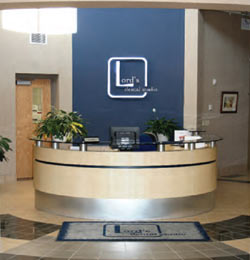 | 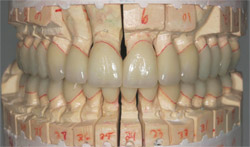 | |
| Figure 1 The lobby area of Lords Dental Studio, Green Bay, WI. | Figure 2 Look for very clean model and die work and precision of fit along with a high esthetic level. | |
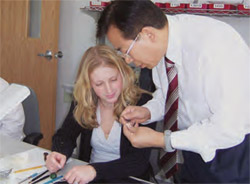 | 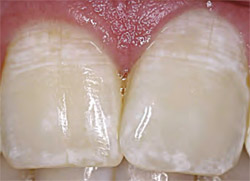 | |
| Figure 3 In-house, hands-on continuing education course for new dentists. | Figure 4 A single ceramic restoration on tooth No. 9 done by the team at Lord's Dental Studio. | |
| About the Authors | ||
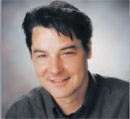 Rick Smith, CDT Rick Smith, CDTLords Dental Studio Green Bay,Wisconsin | ||
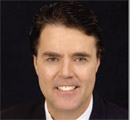 Edward A. McLaren, DDS Edward A. McLaren, DDSAdjunct Associate Professor Director UCLA Center for Esthetic Dentistry and Founder and Director of UCLA Master Dental Ceramist Program UCLA School of Dentistry Private Practice limited to Prosthodontics and Esthetic Dentistry Los Angeles, California | ||



